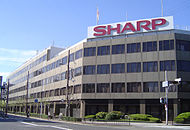- Famicom Titler
-
Famicom Titler 
The Famicom Titler model AN-510.Manufacturer Sharp Retail availability JPN 1989 Media ROM cartridge ("Game Pak") CPU Ricoh RP2CO5 8-bit processor Storage capacity battery backup Controller input 2 Controller Ports Backward
compatibilityNES Predecessor Twin Famicom Successor SF-1 SNES TV The Famicom Titler (ファミコンタイトラー) (also known as the Famicom Editor (編集ファミコン Henshuu Famicom)) is a Nintendo-licensed Famicom-compatible device produced by Sharp Corporation in 1989. The console was released exclusively in Japan at a retail price of 43,000 yen. The system was the only consumer-level Famicom to internally generate RGB video, the only Famicom system with S-Video output, and it has been noted for its crisp clarity of image.[1][2] The system also functioned as a subtitle-generator and it could be used in combination with a RF-video camera to create gameplay videos and demos.[3]
Contents
Overview
Released during a period of close association between Sharp and Nintendo, the Famicom Titler followed the C1 NES TV and the Twin Famicom as the third of what would eventually be four products in the Sharp's Nintendo Console family of products. The Famicom Titler was the most technologically ambitious project that Sharp had attempted with the Famicom system. It was the only commercially available Famicom to internally generate RGB video, and this has been identified as responsible for markedly improved clarity of image over other Famicoms.[1] It is the only Famicom console to employ S-Video output.[2] It also features a keyboard and pressure-sensitive touchscreen that enables users to produce subtitles directly on the screen during gameplay, and to thereby create demos.[3]
Technical specifications
In order to create to S-video output via Nintendo's RP2A03 PPU, an RGB-output-compatible "RC2C05-99" chip was added. Here, RGB video signals generated within the composite outputs were converted to the external S-video signals. At the rear of the Titler's body, RCA composite-pin video outputs and mono audio outputs were located, and peripheral devices could connect only when the video and audio outputs to the associated TV also employed RF connectors and S-Video. This allowed gamers to enjoy a crisper image.
Video editing, subtitling, and demos
With the flip of a switch, the Famicom Titler could be used to produce subtitles for video footage. According to the system manual, the resulting demos were intended to allow the addition of narration in the form of subtitles to create video invitations to parties, holiday events, children's athletic events, weddings, birthdays, and other celebrations.
Character input was made upon a small touch-sensitive tablet mounted into the console. A stylus was included as attached to the body, and audio additions to the demo could be made using the included microphone. Flipping the switch back would superimpose the video and subtitles on the console.
Reception
Although relatively obscure at the time of its release, the console has recently seen increased interest from fans, hackers/modders, and collectors on the secondary market.[3] Apart from historical interest in the system, several features unique to the Famicom Titler make it a popular system for modification and use. The clarity that comes from internal RGB video generation is a prized feature shared only with the considerably rarer PlayChoice-10 system created by Nintendo as an arcade system for store displays and in video arcades. Since the PlayChoice-10 was not released commercially, the Famicom Titler has recently been recognized as an easier way to get a system with the same clarity for a cheaper price.[1] In addition, the fact that the Famicom Titler is the only system to feature S-Video output has meant that the system enjoys compatibility with setups that allow only this form of component video.[2]
See also
- Nintendo Entertainment System
- C1 NES TV
- SF-1 SNES TV
- Twin Famicom
References
External links
Sharp Corporation Divisions and
subsidiariesCurrentiDeep Solutions Corporation · Recurrent Energy · Sharp Electronics Corporation · Sharp Manufacturing Systems Corporation · Sharp Solar · TakayaDefunct
Shareholdings Pioneer Corporation (14%)Products CalculatorsComputersNotebooksPCsPocket and
handheldSharp PC-1211 · Sharp PC-1251 · Sharp PC-1350 · Sharp PC-1401 · Sharp PC-1403 · Sharp PC-1500 · Sharp PC-1600 · Sharp PC-E220 · Sharp PC-E500S · Sharp Wizard · Sharp ZaurusOtherPeople Tokuji HayakawaPlaces Abenobashi Terminal Building Tower · Abeno-ku · Blue Man Group Sharp Aquos Theatre · Yaita
Categories:- Nintendo Entertainment System hardware clones
- Sharp Corporation games consoles
- Japan Only Video Game Hardware/accessories
Wikimedia Foundation. 2010.
